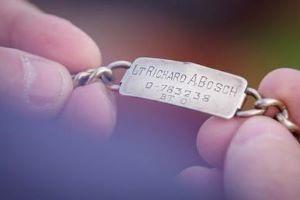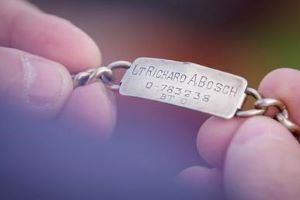

The slightly dented bracelet found at the back of a chest of drawers in a Norwegian attic bore testimony to an epic tale of daring secret missions behind Nazi lines to free Europe of Hitler’s Germany. Seventy-five years, its return to the family of its owner would be a saga all its own.
The bracelet, inscribed on the facing with the name of its owner, “Lt. Richard A. Bosch 0-783238,” was discovered by Jorn Loite, who found it while cleaning out the attic of his grandparents’ home in Drangedal, Norway. An inscription on the underside, possibly from a girlfriend, said “Ever with me, Jo.” As first reported by NRK TV, Loite immediately knew he had a mission: to find out who Bosch was and find a way to send the bracelet back where it belonged.
Bosch, then 25, had been killed with 11 others in the crash of their specially-rigged B-24 Liberator bomber into the snowy face of Plukktjønnfjell mountain, Norway on the night of April 7, 1945.
The dangerous mission for the B-24 crew on that foggy and bitter cold night was to parachute supplies and four Norwegian-Americans to reinforce the small team of Office of Strategic Services saboteurs led by then-Army Maj. William Colby, who would become CIA director in the 1970s.
Colby would later describe the top-secret task of disrupting and blowing up the Nordland railway as “the first and only combined ski-parachute operation ever mounted by the U.S. Army.”
He had previously jumped into occupied France with a unit known as the “Jedburghs,” whose motto was “Surprise, Kill and Vanish.” Colby would take that elan with him for the sabotage missions in Norway.
In a memoir written after the war, Colby recalled the first jump into Norway:
“This is it,” Colby told the pilot as the B-24 neared the drop zone. “I told the men, and they began to buckle on their white equipment. The pilot veered left and angled earthward. Paulsen and Aanonsen pulled up the trap door, and I went through into the awful quiet that closes in when the engines recede.
“Then there was the cold and the wonder if there are friends below — and above. Dimly, I counted the others slipping into the air — one, two, three — formation perfect, five seconds apart. Then my chute opened, now the others.”
Loite found all this out from the Carpetbagger Aviation Museum in Harrington, England. The museum was founded in 1993 for the 50th anniversary reunion of the U.S. Army Air Force‘s 801st/492nd Bomb Group, known as the “Carpetbaggers.”
Museum director Roy Tebbutt confirmed that Lt. Bosch was a bombardier with the Carpetbaggers, known for flying all-black B-24 Liberators on low-level night missions to drop supplies and agents from the OSS, the CIA’s predecessor, into France and later Norway to bolster the resistance.
According to the museum’s website, the Carpetbaggers had 208 aircrew killed in action while dropping 556 agents and 4,511 tons of supplies into enemy territory on a total of more than 3,000 missions, including 21 night bombing runs.
But that was all the museum could offer on Bosch. Enter 94-year-old former Sgt. Bill Becker, who flew with the Carpetbaggers as a top turret gunner out of Harrington.
Becker, treasurer and reunion director for the 801st/492nd Bomb Group, did not know Bosch personally, but was able to put Loite and NRK TV in touch with Linda Bosch Odess, the bombardier’s niece, in Dunellen, Florida. That began a long and stilted effort by the Norwegians to get past COVID-19 restrictions and make a formal presentation of the bracelet to Linda.
Trumpet Player At Pearl Harbor
Bosch was the type of guy who somehow found time away from his secret flying missions out of England to shop for a christening dress for the soon-to-be born niece he would never know and mail it home, Odess, 75, told Military.com. She was born a month after Bosch’s plane went down, on May 7, 1945 — the same day Germany surrendered.
Family lore had it that Bosch was a talented musician and “he left home at 16 to play trumpet with a swing band,” Odess said. He joined the Army in 1941, and one of Odess’s prized possessions was a photo of her uncle with other members of the Army band taken at Pearl Harbor just before the Japanese attack.
Trumpet playing was no longer an option and Bosch wanted to fly, leading to his assignment to the Carpetbaggers in England. “We knew he wanted to be in the air, not slogging with the infantry,” Odess said.
Until the discovery of the bracelet, and the story behind it, the family never knew that his plane had crashed into the mountain. “We thought he’d been shot down by the Germans,” Odess said. “The only story I heard as a child was that the Germans shot him down, but it was foggy and their plane clipped the mountain.”
Odess’s memory as a toddler of the return of her uncle’s remains for burial at Forest Hills Cemetery in Huntingdon Valley, Pennsylvania, is still vivid.
She recalled running around the cemetery, hearing a trumpet play Taps and being frightened by the gun salute that followed.
“Oh, I hated that,” she said. “I was old enough to be running around but not old enough to understand. Everybody was crying.”
Linda was vague on who the “Jo” inscribed on the underside of the bracelet might have been, but said Bosch was “what we used to call a ‘ladies’ man.’ There was no doubt about that.”
To Linda, the discovery of the bracelet was “beyond anything I would have prayed for, a full-blown miracle. To me, this is unbelievable.”
The Norwegians had planned for a formal presentation of the bracelet to Linda by Norwegian-American veterans in Florida. But those plans fell through because of COVID-19 restrictions. Instead, they mailed the bracelet to Linda. By way of a substitute for the presentation, NRK TV arranged a Skype call for Linda with Jorn Loite.
“This is an answer to my prayers. I thank you from the bottom of my heart,” she told Loite. “It was the biggest gift anyone could give me.”
Her “Uncle Dick” was a proud soldier who “loved to fly. He loved his country. He loved helping others,” Linda told Loite.
Retired Col. Ebbe Deraas, a former commander in the Norwegian Home Guard who helped Loite in the search to find Linda, said he has arranged with Linda to donate the bracelet, the Purple Heart and other belongings of her uncle to a museum on the Norwegian resistance and the American contributions to that effort he was setting up in Snasa, Norway.
Linda said it was now on her “bucket list” to visit the museum when it is scheduled to open this September.
Out the “Joe Hole”
Bill Becker, who still cranks out a periodic newsletter called the “Carpetbagger” for the 801st/492nd Bomb Group, said he never knew the names of the quiet guys who sat in the belly of his B-24 waiting to parachute into Norway. The crews just called them all “Joe.”
He also never knew where his plane might be going — the pilot and navigator kept that to themselves. The belly turret guns of the B-24s had been ripped out and replaced with a lid that would open up to let the soldiers assigned to the OSS make their jumps. The crews called it the “Joe Hole.”
“I never knew the agents that we might be dropping,” Becker said. All he knew was that, from time to time, a black Chevrolet would pull up next to his plane and several paratroopers would step out, just before takeoff. “They got on at the last minute,” he said.
The crews were all sworn to secrecy and for years after the war never spoke of their experiences — not to their families or anyone else, Becker said.
The “Joes” were mostly Norwegians and Norwegian-Americans specially recruited for the 99th Infantry Battalion (Separate), known as the “Viking Battalion,” said Erik Brun, a retired Army National Guard lieutenant colonel whose father, Christian Brun, served in the 99th.
They trained in alpine warfare at Camp Ripley and Fort Snelling in Minnesota, and at Camp Hale in Colorado, with other troops who would later form the Army’s 10th Mountain Division.
Troops from the 99th would participate in Operation Rype, the Norwegian word for “Grouse,” in the effort to liberate Norway from the Nazis. They’d later form the honor guard for the return of King Haakon VII to Norway in June 1945.
In an official report to the Army on the crash of Bosch’s plane into the mountain, Colby, the major who later became CIA director, wrote that members of his unit thought they heard the sound of a crash on April 7, 1945. A patrol was sent to investigate but found nothing and had to turn back in bad weather.
A local reindeer herder later informed the Colby unit of the approximate location of the crash, and on April 22, a second patrol found the site. Colby wrote that the plane appeared to have hit the mountain and then bounced down the craggy slope.
“It is also believed from the conditions and positions of the bodies that all were killed instantly,” Colby wrote. The plane itself was shattered in pieces, but all 12 bodies were identifiable from their dog tags.
“The bodies were removed from the wreck and wrapped in parachutes found in the area,” and “they were buried in a rock cavern on a slight knoll overlooking the site,” Colby wrote. “A brief ceremony was held at the site and an American flag was placed over the grave.”
All 12 bodies were recovered after the war and the remains were returned to their families.
— Richard Sisk can be reached at [email protected].
© Copyright 2021 Military.com. All rights reserved. This material may not be published, broadcast, rewritten or redistributed.
